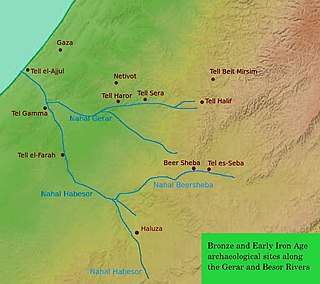Haluza
Haluza (Arabic: الخلصة; Hebrew: חלוצה), also known as Al-Khalasa, Halasa, Chellous (Χελλοὺς in Greek, although in the 6th-century Madaba Map the town appears as ΕΛΟΥϹΑ), Elusa, al-Khalasa and al-Khalūṣ (Arabic), was a city in the Negev near present-day Kibbutz Mash'abei Sadeh that was once part of the Nabataean Incense Route. It lay on the route from Gaza to Petra.[1]
חלוצה - الخلصة | |
 | |
 Shown within Israel | |
| Alternative name | Halasa Chellous al-Khalasa Elusa |
|---|---|
| Location | Southern District, Israel |
| Region | Negev |
| Coordinates | 31.097°N 34.652°E |
| Type | Settlement |
| History | |
| Cultures | Nabataean, Roman |
| Site notes | |
| Condition | In ruins |
| Official name | Incense Route - Desert Cities in the Negev (Haluza, Mamshit, Avdat and Shivta) |
| Type | Cultural |
| Criteria | iii, v |
| Designated | 2005 (29th session) |
| Reference no. | 1107 |
| State Party | Israel |
| Region | Europe and North America |
In the 5th century it was surrounded by vinyards and was famous for its wines.[1]
Due to its historic importance, UNESCO declared Haluza a World Heritage Site along with Mamshit, Avdat and Shivta.
Name
In Saadia Gaon's Judeo-Arabic translation of the Pentateuch, the biblical town of Gerar is associated with Haluza (Judeo-Arabic: 'אלכ'לוץ = al-Khalūṣ).[2]
The city is called 'Chellous' (Χελλοὺς) in the Greek text of Judith, i, 9. It is also mentioned by Ptolemy (as being in Idumaea),[3] Peutinger's Table, Stephanus Byzantius (as being formerly in the province of Arabia Petraea, but "now" in Palaestina Tertia), Jerome,[4] the pilgrim Theodosius, Antoninus of Piacenza, and Joannes Moschus.[5]
Jerome's life of St. Hilarion mentions a great temple of Aphrodite in Elusa in the 4th century.[6] Hilarion is supposed to have introduced Christianity to Elusa in the fourth century.[7]Early in the following century, a Bishop of Elusa, after redeeming the son of Nilus of Sinai, who had been carried off from Mount Sinai by the Arabs, ordained both him and his father.[8] Other bishops known are Theodulus, 431; Aretas, 451; Peter, 518; and Zenobius, 536.[9]
Archaeology

The ruins of Halusa are located in a large plain 20 km (12 mi) southwest of Beersheba, Israel. Many inscriptions have been found there.[10] In the vicinity, according to the Targums, was the desert of Sur with the well at which the angel found Hagar (Genesis 16:7). (See Revue Biblique, 1906, 597).
In 2014, two archaeological survey-excavations were conducted at Haluza on behalf of the University of Cologne in Germany and Haifa University.[11] Archaeological surveys of the area are partly hampered by the presence of shifting sands. However, Nabataean streets have been found, along with two churches, a theatre, wine press and tower.[12]
The bishopric of Elusa is included in the Catholic Church's list of titular sees.[13]
In March 2019, a team of German and Israeli archaeologists announced the discovery of a 1,700-year-old Greek inscription, bearing the name of the city of Elusa.[14]
By analysing rubbish removed from the city, it has been determined that it underwent a major decline around the middle of the sixth century, about a century before the Islamic conquest.[15] The excavators propose that their findings call for a reevaluation of the settlement history of the Negev region in the late Byzantine period.[15] One possible cause for the crisis is raised as the Late Antique Little Ice Age, a cold snap believed to have been caused by "volcanic winter".[16]
See also
References
- Carta's Official Guide to Israel, 1983.
- Rabbi Saadia Gaon's Judeo-Arabic Translation of the Pentateuch (Tafsir), s.v. Genesis 10:19, Genesis 20:2, Genesis 26:17, 20. On Haluza's proximity to Gerar, see: M. Naor, Gerar — Tell el Far'a, Bulletin of the Israel Exploration Society (1955), pp. 99–102 (Hebrew)
- V:xv:10
- In Isaiam V:xv, 4
- Pratum Spirituale, clxiv
- "Vita Sancti Hilarionis", 25, in Patrologia Latina, XXIII, col.41
- Jerome, loc.cit.
- Patrologia Graeca LXXIX:373-93
- Lequien, Oriens Christianus III, 735
- Revue Biblique, 1905, 246-48, 253-55
- Israel Antiquities Authority, Excavators and Excavations Permit for Year 2014, Survey Permits # G-67 and # G-69.
- The Incense Route (Israel) UNESCO
- Annuario Pontificio 2013 (Libreria Editrice Vaticana, 2013, ISBN 978-88-209-9070-1), p. 888
- "Unique 1,700-year-old Greek inscription unearthed at Incense Route city in Negev". The Times of Israel. 13 March 2019.
- Guy Bar-Oz and 21 others (2019). "Ancient trash mounds unravel urban collapse a century before the end of Byzantine hegemony in the southern Levant". Proceedings of the National Academy of Sciences. doi:10.1073/pnas.1900233116.
External links
- Incense Route - Desert Cities in the Negev UNESCO
- The Madaba Mosaic Map - Discussion 109. Elusa - (al Khalasa)
- Stops on the Incense Road - Elusa
